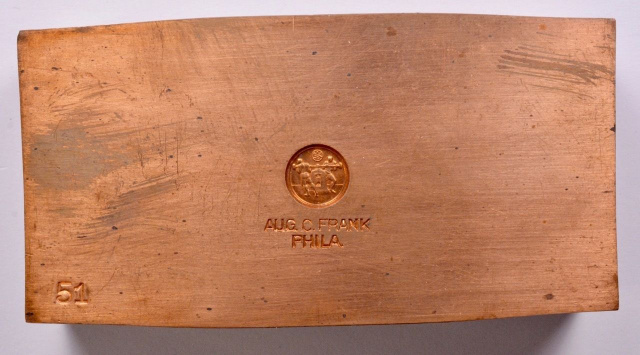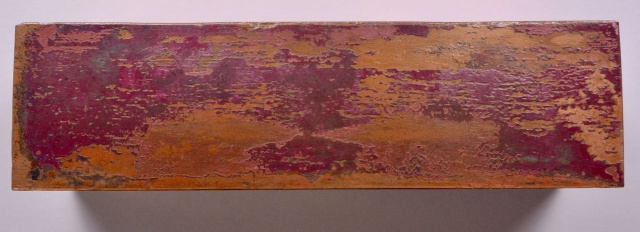1861 Confederate Cent Bashlow Restrike Copper Ingot # 51 of 100 (PAPERWEIGHT)
Price: $2,500.00
Availability: in stock
Prod. Code: Historical
The Confederate Cent is a great rarity. The origin of the Confederate cent is as follows: in 1861 an official of the Confederate States of America contacted the jewelry firm of Bailey & Co (later Bailey, Banks, and Biddle) and requested a die cutter who could make a C.S.A. cent.
Robert Lovett, Jr. was selected, and he was a logical choice, as he had extensive experience with die engraving. Lovett employed the head of Minerva, which he had used on an earlier one cent sized token from 1860, and employed a wreath of distinctive Southern agricultural products, including a bale of cotton at the bottom.
Lovett struck twelve coins with his dies, employing the then current Union alloy of copper and nickel used on Indian cents. Lovett soon had second thoughts, and fearing arrest by Union authorities for aiding the Confederates, he canceled the project and concealed the dies and dozen coins.
After the war ended, Lovett took one of the coins and used it as a pocket piece. One day in 1873, Lovett accidentally spent the Confederate cent at a Philadelphia bar. The barkeep recognized the piece as unusual and showed the coin to a numismatist friend. Or so the story goes.
In any event, Edward Maris, a prominent Philadelphia collector learned of the coin and its source. Maris contacted Lovett and purchased not only the other coins, but the dies too.
Soon Capt. John W. Hazeltine and his associate J. Colvin Randall learned of the coins and dies, and procured them from Maris or possibly Lovett (if Maris hadn't purchased the dies). A plan was hatched to coin restrikes, and Peter Kinder (a medalist and die sinker) of Philadelphia was engaged for this purpose. A pamphlet was produced which stated that seven gold, twelve silver, and 55 copper restrikes had been made, with the dies breaking on the 55th copper strike. No copper nickel restrikes were made to preserve the integrity of the original dozen coined by Lovett.
In 1961 Robert Bashlow, a New York entrepreneur, took the rusted and broken dies and had copies made by the transfer process. These pieces have irregular surfaces, and are quite unlike the 1874 restrikes. PCGS has only graded a few examples of this important issue. Perhaps the others are tied up in collections, or simply haven't been graded as of yet.
This is an 1861 Bashlow restrike Confederate cent copper ingot, which is a curiosity produced by Bashlow when he was creating the cent restrikes in the early 1960's. There are estimated to be in the neighborhood of 100 of these ingots produced, and they infrequently appear for sale on the market.
The actual dies used were copy dies of the original Confederate cent dies (those dies are now in the Smithsonian--both sets the original and the copy dies.)
A very neat item, and quite scarce.
Walter Breen, in his Complete Encyclopedia of U.S. and Colonial Coins, made a note that Bashlow had fancy pieces struck. One is a paperweight (ingot) made using a block of bronze. The obverse and reverse dies were deeply impressed side-by-side on one side of the block. The blocks bulged since no retaining collar was used. Authentic paperweights are 3 1/16 inches long, 1 1/2 inches wide and 7/8 inch thick.
Here is a great read that you may enjoy....
By David Thomason Alexander for CoinWeek ....
THE CAST OF CHARACTERS in American Numismatics over the last century-and-a-half has included many an odd personality, whether in the ranks of collectors, dealers, researchers or story tellers.
Some of these were well known figures who devoted decades to the field, often as professional coin auctioneers such as Captain John Haseltine, Edward Cogan, S. Hudson Chapman and his brother Henry.
Others spent years in profound research and publishing while sometimes pursuing highly unorthodox private lives. In the late 19th century, C. Wyllys Betts created unique “discovery” copper coins by carving novel designs into worn-out copper planchets. He went on to become the highly respected pioneer cataloger of medals relating to the colonial era of the Western Hemisphere.
The late Walter Breen and his erstwhile mentor Dr. William H. Sheldon were outstanding examples of genius-level researchers in such fields as early American coppers and colonial coins; both eventually gained notoriety for outside activities that scandalized their many admirers.
Collectors active in the early 1960s will recall a more recent figure who advertised heavily in the early days of the weekly numismatic newspaper Coin World, Robert Socrates Bashlow (born June 21, 1939, died July 12, 1979). Numismatists who knew Bashlow in his heyday, such as Q. David Bowers, recall that his parents were respectable and well-off, manufacturers of precision anti-dust laboratory equipment.
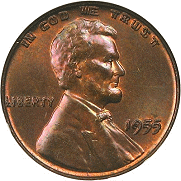 Bashlow’s early career as a professional numismatist blossomed in the heyday of the 1955 Double Date Lincoln cent, a marvelous Philadelphia Mint product that featured boldly doubled digits in the date and doubled lettering in the obverse legend. Apparently 20,000 to 24,000 examples were struck with this bungled obverse die and were mixed in with 10 million cents awaiting packaging and release into circulation.
Bashlow’s early career as a professional numismatist blossomed in the heyday of the 1955 Double Date Lincoln cent, a marvelous Philadelphia Mint product that featured boldly doubled digits in the date and doubled lettering in the obverse legend. Apparently 20,000 to 24,000 examples were struck with this bungled obverse die and were mixed in with 10 million cents awaiting packaging and release into circulation.
The error coins were discovered, but it was decided that searching the entire mass to retrieve the error pieces was impractical and all were released to circulation. Many Double Die pieces ended up inside the cellophane wrappers of Pall Mall cigarettes, serving as instant change for a quarter in coin-operated vending machines in eastern Massachusetts.
After this variety was discovered and publicized, its value skyrocketed. Fast-moving dealers bought and sold Double Date pieces at several points during their dramatic rise in an overheated coin market. Fortunes were made, and the young Bashlow racked up hefty profits.
In the next phase of his career, Bashlow worked with wholesale dealer David Laties in importing and mass-marketing several types of modern British bronze coins to American collectors. Bashlow’s name became associated with such companies as White Oak Trading Co. and Williams Trading Co. in importing immense quantities of recent-date British bronze coins for sale to American collectors seeking entry into what appeared to be a new collecting area.
Britain had initiated a series of dramatic changes in its circulating coins, beginning with discontinuation of the bronze farthing (1/4 penny), the lowest denomination then in circulation. The last date was 1956, with 1.9 million struck - a relatively low total, which excited little interest among British numismatists who collected their country’s coins by type rather than by date. The farthing was demonetized in 1960 with little mourning.
Coin World was still in its infancy and its owners and most of the early staff knew little of world coins. The publisher began accepting massive advertising for the purportedly scarce and elusive farthings, offered in groups or as singles described in breath-taking prose in ads predicting the wonders that the coins were sure to usher in.
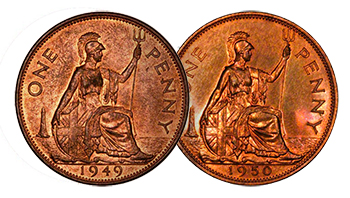 Bashlow’s research into modern British coinage found additional opportunities for ballyhoo. The bronze penny had been a key component of British coinage for centuries but its popularity faded as inflation ate into its spending power. In 1949, The Royal Mint struck 14,314,000 pennies, quantities of which remained in dead storage as circulation demand remained limited.
Bashlow’s research into modern British coinage found additional opportunities for ballyhoo. The bronze penny had been a key component of British coinage for centuries but its popularity faded as inflation ate into its spending power. In 1949, The Royal Mint struck 14,314,000 pennies, quantities of which remained in dead storage as circulation demand remained limited.
Nonetheless, the Royal Mint struck 240,000 pennies in 1950, with an additional 120,000 following dated 1951. Most coins bearing these dates were shipped overseas for circulation in Bermuda and the Bahamas where they suffered not only circulation but the effects of tropical and marine environments. Becoming aware of their story, Bashlow journeyed to the colonies to acquire masses of circulated examples for typically splashy advertising in the U.S.
After this, Bashlow’s interest was focused on the Centennial of the American Civil War, a multi-year event celebrated throughout the country. It included the issuance of dozens of official and private medals, ranging from the official national medal by sculptor Joseph Renier to coin-relief medals hailing the death of the first Confederate officer from Louisiana.
Bashlow soon discovered a Civil War item of vastly greater significance: the pattern cent struck for the Confederacy by Philadelphia die sinker Robert Lovett Jr. soon after secession and the creation of the Confederate States of America. Bashlow’s involvement with this enigmatic coin merely continued controversies dating to its discovery in 1874.
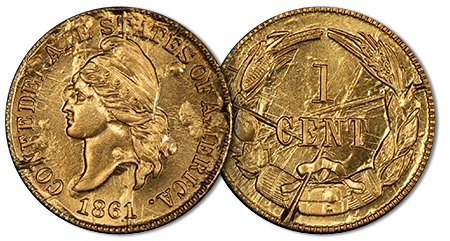 There were already several stories of the coin’s origin.
There were already several stories of the coin’s origin.
Lovett himself was a well-regarded artisan, and had engraved a distinctive capped Liberty head for use on the tokens he was making for merchants in the North as federal coins were vanishing from circulation. Confederate agents approached him via leading silversmiths Bailey, Banks and Biddle to offer a contract for design and manufacture of coins for their new government.
It is known that contracts for printing Confederate paper money had already been offered to New York printers in these confused days before Lincoln’s government had decided on non-intercourse with it new Southern rival... why not coinage as well? Lovett (it was said) accepted at least part of the Southern offer, creating obverse dies bearing his distinctive Liberty and the legend CONFEDERATE STATES OF AMERICA 1861.
The reverse bore a wreath of rice, tobacco and cotton, with a minute signature “L” around 1/CENT. Lovett supposedly asserted that he had struck 12 pieces in copper-nickel, hiding 11 and the dies in fear of arrest for trading with the enemy and carrying one as a pocket piece. After this, the story becomes increasingly murky. Part seems true: that Lovett accidentally spent his pocket piece in a favorite Philadelphia tavern.
The barkeep brought the mysterious coin to the attention of flamboyant Philadelphia coin dealer Captain John Haseltine, or perhaps to “kindly old Quaker Doctor” Edward L. Maris, famed student of the New Jersey copper coins of the early Federal era. Captain John was an inveterate spinner of yarns who told at least two different stories about the numbers of Restrikes he had struck using these dies, always emphasizing that the numbers were small.
His Restrikes were made by Philadelphia medalist Peter L. Krider in gold, silver and copper, but not copper-nickel, after which it was erroneously reported that the dies had broken. The probability was that they were lightly file-cancelled to impede further use.
The dies vanished from public sight until they reappeared at the 1911 American Numismatic Association convention, exhibited by prominent collector Judson Brenner. Then they appear to have passed to acquisitive Union News mogul F.C.C. Boyd, longtime officer of the prestigious New York Numismatic Club. He in turn moved them on to dealer John J. Ford Jr. of New Netherland Coins. Always interested in usable dies, Ford was later famed for his interest in Western and Gold Rush numismatics.
Showing cancellation lines and blobs of die rust, the Confederate cent dies were sold to the youthful Q. David Bowers, then launching a distinguished numismatic career. Based at the time in Binghamton, New York, Bowers made no use of the dies but sold them to a frequent visitor from New York City, the young Robert Bashlow.
The possession and use of these dies brought Bashlow’s name before the larger American numismatic community. He had earlier promoted interest in more mainstream coins, the scarce silver Newfoundland 1946-C five-cent coins and U.S. Flying Eagle cents. He was operating from the address of One Washington Square in lower Manhattan where he maintained an attractive but disordered apartment. In that he resembled his mentor Walter Breen.
He also acquired the vast die inventory of the defunct Joseph K. Davison’s Sons firm of Philadelphia, makers of a galaxy of badges for the Grand Army of the Republic and various 19th-century fraternal organizations. The Confederate Cent dies were brought to an old Philadelphia firm, August C. Frank and Company, and Bashlow directed them to reproduce both obverse and reverse by the hubbing process that also copied every cut and blob in the original dies.
Some 30,000 impressions were eventually made from these copy dies in a variety of different metals and die thicknesses as two-sided pieces and as impressions on rectangular planchets. These were relentlessly advertised with double-truck (facing pages) ads in the numismatic press, especially Coin World. The original and copy dies were later donated with requisite fanfare to the Smithsonian Institute.
All Bashlow ads were bold and flashy, featuring borders of Confederate flags, garish typefaces presenting a barrage of breathless claims about the great opportunities that this SECOND RESTRIKE OF THE CONFEDERATE CENT offered to the trusting reader. Intense controversy erupted over these claims. Just what was a “Second Restrike"? What were "copy dies" and why should anything struck from them have any value at all? And besides, who was this Robert Bashlow?
Sales of the Confederate pieces continued, perhaps sped up by the publicity generated by this ongoing debate. Meanwhile, Bashlow was preparing and advertising Restrikes and re-creations made with an odd assortment of dies he had acquired from the wreckage of vanished Philadelphia-area firms.
Typically flashy ads now proclaimed the attractions of a fantasy Sommers Islands “Hogge” shilling; mules employing the reverse of the 1909 Thomas L. Elder-Frank Higgins Hendrik Hudson Daalder and a large issue of recreations of the Continental Currency dollar. None of these, however, had the appeal of the Confederate pieces, and Bashlow’s irregular finances imperiled his arrangements with August C. Frank & Co.
Powerful voices were now being raised against Bashlow and his products. The late Russ Rulau had retired from the military to enter the numismatic writing field full time. An active politically right-wing conservative, he objected to a Bashlow pamphlet entitled “1,000 Ways to Evade the Draft.” Rulau later stated that it was he who convinced Coin World Publisher J. Oliver Amos to reject continued Bashlow Restrike advertising as deleterious to the hobby.
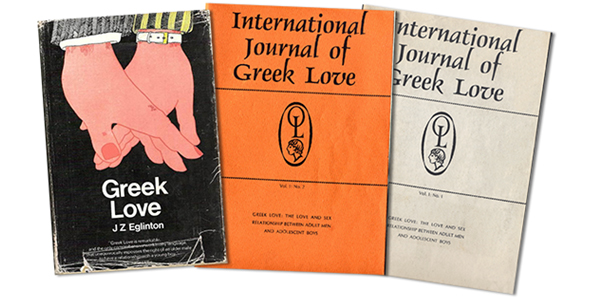
Rulau did not know of Bashlow’s role in the Oliver Layton Press, publisher of his friend Walter Breen’s controversial pedophilia advocacy book Greek Love under the pseudonym J.Z. Eglinton, or of the short-lived journal he launched with Breen and his wife Marion Zimmer Bradley, the International Journal of Greek Love.
These would receive belated publicity at Breen’s trials for child abuse in the early 1990s. Bashlow also created the defamatory 32 millimeter anti-John F. Kennedy medal inscribed “Catholic States of America, In the Pope We Hope”, struck in 1963 by John Pinches Ltd. in England.
By the time the present writer joined the Coin World staff in 1974, Bashlow was no longer an active advertiser but his memory lingered on. His disappearance had more to do with his habit of racking up hefty advertising tabs that were never paid than to philosophical objections to his Restrikes.
August C. Frank confiscated his die stash to meet unpaid bills and the firm subsequently sank into bankruptcy. Medallic Art Company (MACO) of Danbury purchased the Frank die holdings and arranged their shipment to Connecticut. MACO neglected to supervise the loading, and unidentified movers tossed hundreds of dies into open 55-gallon drums aboard a flatbed truck. They journeyed north in torrential rain that filled the barrels and completed the destruction caused by the clink-bang-crash die tossing. Bad luck tailed the whole transaction until its end.
Among the last headlines scored by Bashlow came in 1962 with the Secret Service seizure of a rusted reverse die for an 1814 U.S. dime with distinctive legend showing STATESOFAMERICA run together as one word. It is believed that this die was among several disposed of by the Mint as scrap metal in 1833. Several were obtained by pioneer collector Joseph J. Mickley for his use in creating unauthorized strikes.
Bashlow reportedly obtained the dime reverse and had coupled it with a fantasy die inscribed GOD PRESERVE PHILADELPHIA AND THE LORDS PROPRIETERS (sic). This language and misspelling were inspired by rare copper elephant tokens of a more distant era. Walter Breen recorded in his Complete Encyclopedia that 536 impressions were struck in Scotland from this die at Bashlow’s order.
Someone tipped off the U.S. Secret Service, however, and Bashlow was detained after his plane landed. The 536 pieces and die were seized and ultimately destroyed, despite the pleas of Smithsonian Institution’s numismatic curator Dr. Vladimir Clain-Stefanelli.
No one knows how many other dies Bashlow had possessed. In mid-1974, I received, from Advertising Vice President Wayne Lawrence, a number of copper uniface trial strikes from random dies abandoned by Bashlow years before, along with his unpaid bills. These were dies for small-diameter pieces presenting one side of many two-sided medalets of no great historical importance, which gave an idea of the sheer variety of designs involved in Bashlow’s holdings.
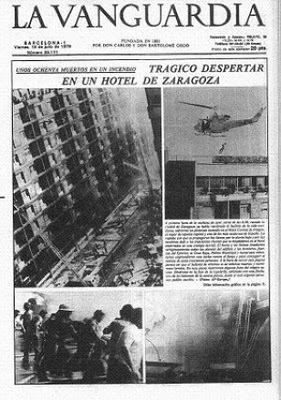 I actually met Bashlow in Sidney* some time after the 1976 Amos Press layoffs that truncated the Coin World staff and saw the demise of the influential monthly magazine World Coins and the enfeebled Numismatic Scrapbook. Among those laid off was an English couple, World Coinsassistant editor John G. Humphris and Coin Worldcoin society writer Margaret Humphris, whose apartment was next door to mine. I was invited over one evening to meet a somewhat rotund young man with afro-like hair, who was introduced “David, this is Bob Bashlow!”
I actually met Bashlow in Sidney* some time after the 1976 Amos Press layoffs that truncated the Coin World staff and saw the demise of the influential monthly magazine World Coins and the enfeebled Numismatic Scrapbook. Among those laid off was an English couple, World Coinsassistant editor John G. Humphris and Coin Worldcoin society writer Margaret Humphris, whose apartment was next door to mine. I was invited over one evening to meet a somewhat rotund young man with afro-like hair, who was introduced “David, this is Bob Bashlow!”
The conversation that ensued was distinctly anti-Amos, and I soon excused myself. “You takes the King’s shilling and you keeps his bargain,” as the old Irish proverb had it. It is possible that Bashlow had resumed activity in the massive-quantity wholesale world coin trade that launched him into commercial numismatics.
Bashlow was expelled from the American Numismatic Association in 1962. It was reported that he had died in a raging fire that swept through the Corona de Aragon Hotel in Zaragoza, Spain, on July 12, 1979. The fire claimed the lives of 80 guests, but no cause for this conflagration was ever published.
Among conspiracy theorists it was whispered that Bashlow faked his own death to evade legal problems stemming from his long association with Walter Breen and his non-numismatic interests. Such a suggestion, of course, cannot be proven.

